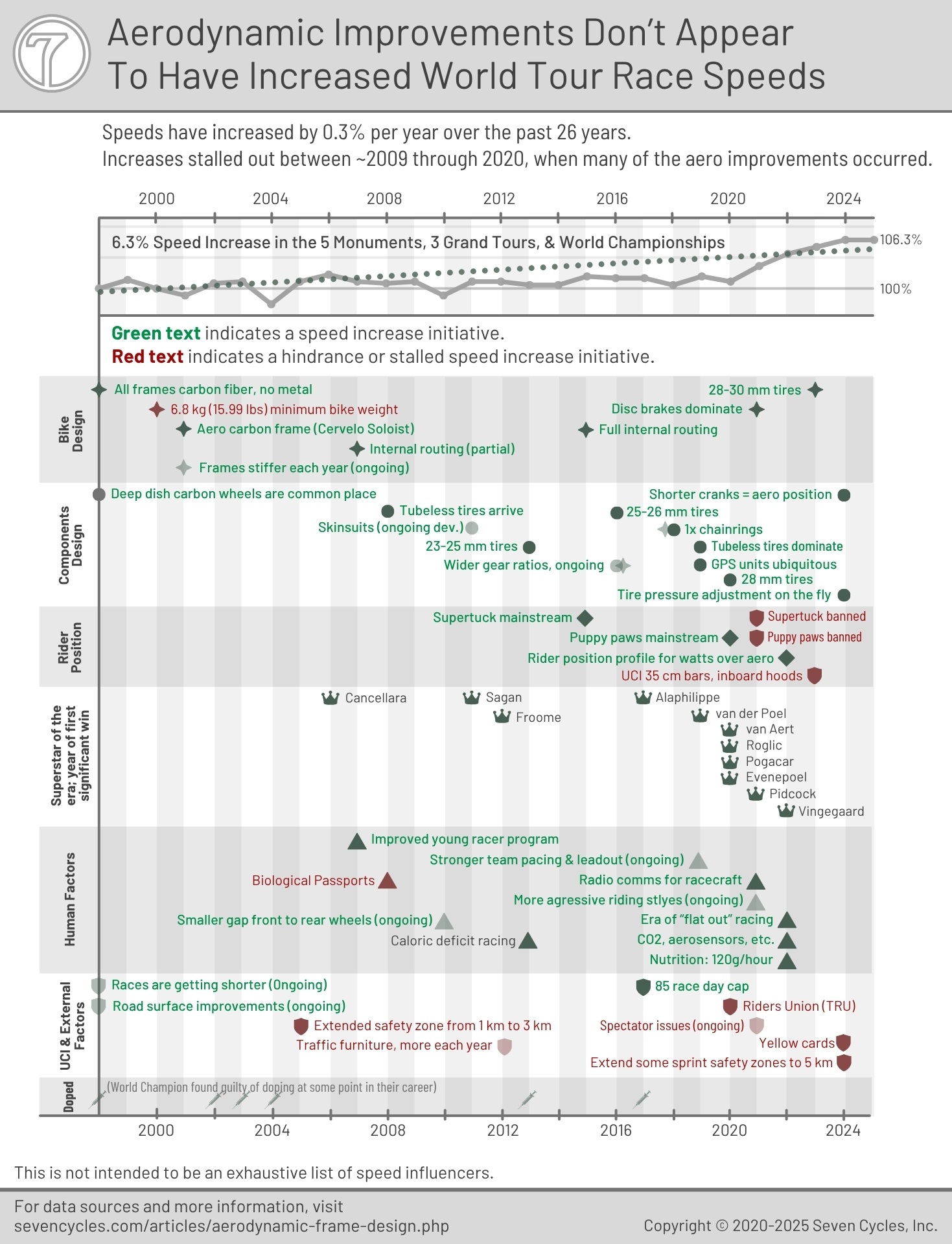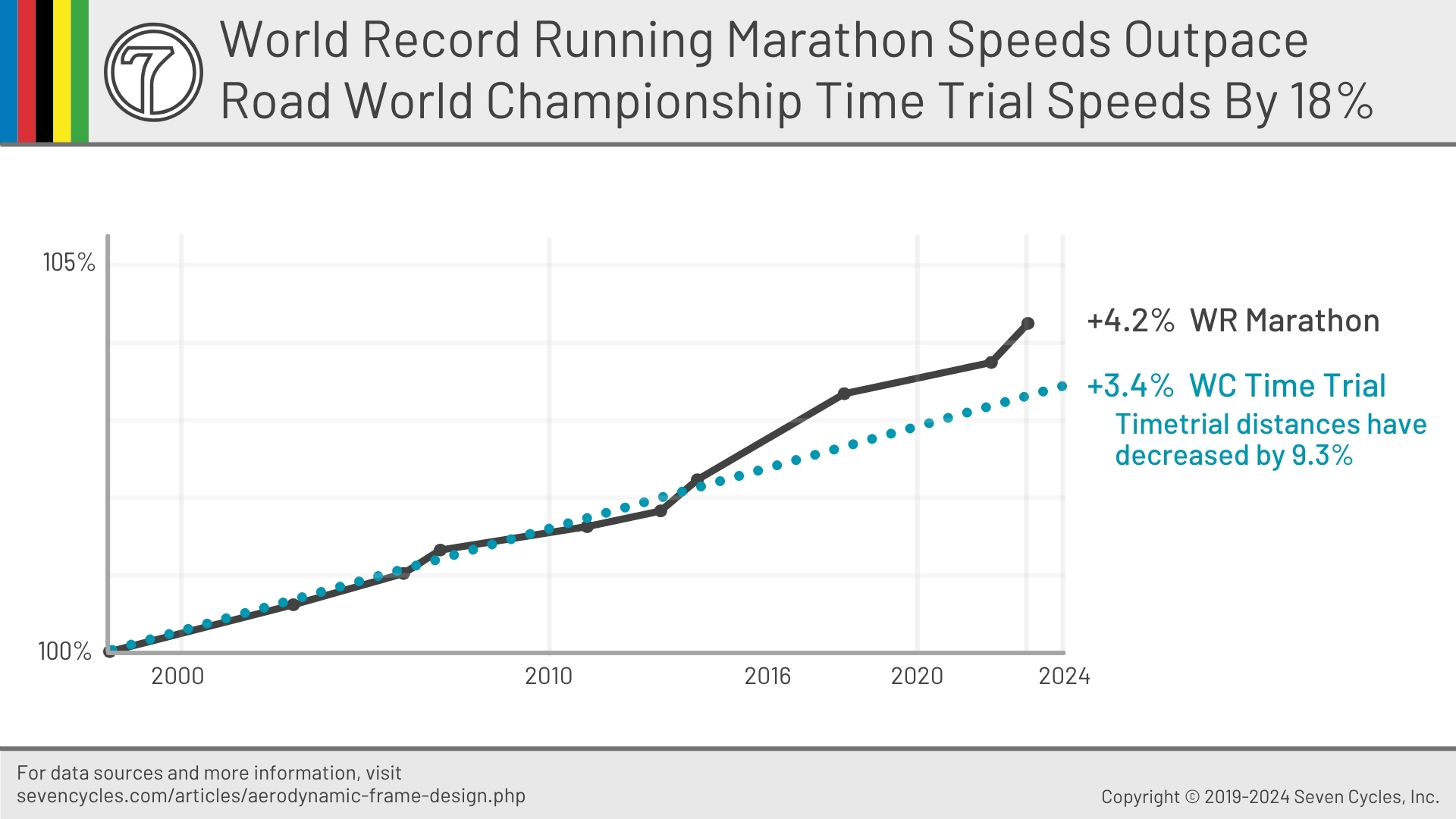Aerodynamic Gains In Wind Tunnels Do Not Show Up In Pro Peloton Speed
The data suggest that aerodynamic modifications are making bikes slower. More problematic, aero bikes are unquestionably more dangerous than bikes from thirty years ago.
Aerodynamics are sold as game changers for speed. It's easy to tally up 200-plus spreadsheet watts from marginal gains of aero socks, teardrop helmets, belly hydration packs, jockey wheel covers, etc. The funny thing is, road pros don't seem to benefit from these miracles, so it's unlikely that anyone else will, either.
Seven is only concerned with aerodynamic snake oil as it relates to framesets — since we're framebuilders. Wind tunnel tests typically tally somewhere between 5 to 20 watts for an aero frameset. Generally, two distinct aero parsings exist in the frame world: 1) the frame's tube shapes and 2) internal housing routing.
Internal routing gains anywhere between 1 and 2 watts if one is really lucky. For all the downsides of internal routing, including the literal danger of brake failure, a watt doesn't sound worthwhile. As a side note, Seven offers internal housing routing for riders who need it. However, we don't promote it as an aero benefit; it is purely aesthetic. Potato, paataato.
Aero frame watt gains are usually touted in the single digits up to about 20 watts. The data is typically calculated at about 28 mph (!?) and sans rider. Since most bikes have riders, the watt advantage shrinks because of all the dirty air produced by a rider. And most riders don't ride at 28 mph. Regardless, gaining 5 to 10 watts for free sounds okay. But it's not free. The tradeoff shows up in bike behavior. Read Seven's "More Crashes. The Cost of Progress?" for details.
Whether the cost of safety is worth it or not, the areo gains don't exist. Three examples are the World Championship time trial each year (Figure 1 and Figure 3) and World Tour races year after year (Figure 2).
World Champion Time Trialists Don't Benefit From Bike Tech
Figure 1 illustrates how difficult it is to find any measurable benefit of bike tech or aerodynamic improvements. The speed trend line increases by about 0.1% annually. The distance trend line shortens by about 0.3% annually, thereby helping increase speed. Two dozen other factors should be increasing time trial speeds, as enumerated in Figure 2. Where are those gains?

World Tour Road Race Speeds Increase By 0.07 MPH Each Year
Not much to get excited about. As Figure 2 illustrates, the past 27 years have produced dozens of significant improvements in bike speed, athlete speed, race tech, and race craft. Despite all this, speeds in the Great Eight races have barely increased (0.07 mph per year on average over the past 27). More to the point, aerodynamic framesets cannot possibly make any impact on race speed. If they did, it would mean that everything else is getting worse and slowing down the peloton. Which seems more likely?

Road Racing Speed Gains Outpace World Champion Time Trial Gains
Another way to parse the data: World Championship time trial speed increases vy 0.04 mph annually (Figure 1). World Tour Great Eight race speed increased by 0.07 mph annually over the same period (Figure 2). How is road racing getting faster, faster than WC TT? Aerodynamic gains in time trial bikes and rider positions in wind tunnel testing must provide more gains than road bikes and rider positions in wind tunnel testing.
World Champions Time Trialists Can't Keep Up With Marathon Runners
How much of any speed increase is attributable to human performance improvements versus equipment technology improvements? We used marathon running to evaluate and isolate human performance improvement. There exist a few good correlations between running and riding (they're both mature sports with similar effort time and available data). Marathon is also good because there's not much equipment tech relative to road bike racing. Human performance is the lion's share of the speed outcome. We would expect that tech-savvy WC time trial gold medalists would improve year after year at a faster rate than low-tech marathoners. The opposite is true.
Figure 3 shows that marathon world record speeds have increased by 4.2% compared to World Championship time trial gold at 3.4%. This is a 24% variance. With all that bike and body tech, it's not clear why runners would post better gains. Seven's hypothesis is that the bike tech is, at best, not helping increase speed. More likely, it is causing problems with speed.

The Great Eight
This is a term Seven made up for studying race craft and modern bike design's influence on the Pro Peloton's performance. The Great Eight are the five monuments and the three Grand Tours:
- Liege-Bastogne-Liege (M)
- Paris-Roubaix (M)
- Tour of Flanders (M)
- Milan-San Remo (M)
- Il Lombardia (M)
- Giro d'Italia (GT)
- Tour de France (GT)
- La Vuelta a Espana (GT)
We use these races in part because a lot of data exists for them over the past 50+ years. Also, because these eight are the most prestigious events of the road season, they are likely to have the most at stake, so riders use the highest tech equipment, ride their fastest, and generally focus on these events more than others.
